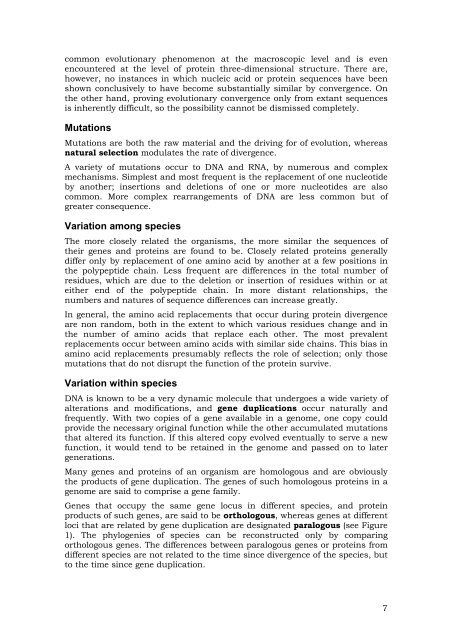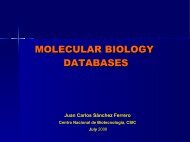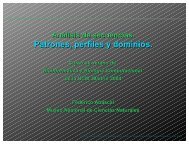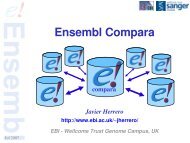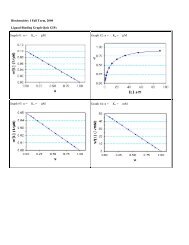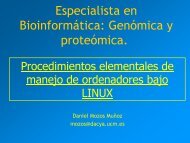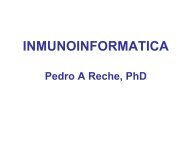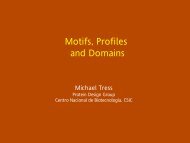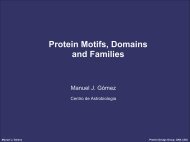Practical Course on Multiple Sequence Alignment - CNB - Protein ...
Practical Course on Multiple Sequence Alignment - CNB - Protein ...
Practical Course on Multiple Sequence Alignment - CNB - Protein ...
Create successful ePaper yourself
Turn your PDF publications into a flip-book with our unique Google optimized e-Paper software.
comm<strong>on</strong> evoluti<strong>on</strong>ary phenomen<strong>on</strong> at the macroscopic level and is even<br />
encountered at the level of protein three-dimensi<strong>on</strong>al structure. There are,<br />
however, no instances in which nucleic acid or protein sequences have been<br />
shown c<strong>on</strong>clusively to have become substantially similar by c<strong>on</strong>vergence. On<br />
the other hand, proving evoluti<strong>on</strong>ary c<strong>on</strong>vergence <strong>on</strong>ly from extant sequences<br />
is inherently difficult, so the possibility cannot be dismissed completely.<br />
Mutati<strong>on</strong>s<br />
Mutati<strong>on</strong>s are both the raw material and the driving for of evoluti<strong>on</strong>, whereas<br />
natural selecti<strong>on</strong> modulates the rate of divergence.<br />
A variety of mutati<strong>on</strong>s occur to DNA and RNA, by numerous and complex<br />
mechanisms. Simplest and most frequent is the replacement of <strong>on</strong>e nucleotide<br />
by another; inserti<strong>on</strong>s and deleti<strong>on</strong>s of <strong>on</strong>e or more nucleotides are also<br />
comm<strong>on</strong>. More complex rearrangements of DNA are less comm<strong>on</strong> but of<br />
greater c<strong>on</strong>sequence.<br />
Variati<strong>on</strong> am<strong>on</strong>g species<br />
The more closely related the organisms, the more similar the sequences of<br />
their genes and proteins are found to be. Closely related proteins generally<br />
differ <strong>on</strong>ly by replacement of <strong>on</strong>e amino acid by another at a few positi<strong>on</strong>s in<br />
the polypeptide chain. Less frequent are differences in the total number of<br />
residues, which are due to the deleti<strong>on</strong> or inserti<strong>on</strong> of residues within or at<br />
either end of the polypeptide chain. In more distant relati<strong>on</strong>ships, the<br />
numbers and natures of sequence differences can increase greatly.<br />
In general, the amino acid replacements that occur during protein divergence<br />
are n<strong>on</strong> random, both in the extent to which various residues change and in<br />
the number of amino acids that replace each other. The most prevalent<br />
replacements occur between amino acids with similar side chains. This bias in<br />
amino acid replacements presumably reflects the role of selecti<strong>on</strong>; <strong>on</strong>ly those<br />
mutati<strong>on</strong>s that do not disrupt the functi<strong>on</strong> of the protein survive.<br />
Variati<strong>on</strong> within species<br />
DNA is known to be a very dynamic molecule that undergoes a wide variety of<br />
alterati<strong>on</strong>s and modificati<strong>on</strong>s, and gene duplicati<strong>on</strong>s occur naturally and<br />
frequently. With two copies of a gene available in a genome, <strong>on</strong>e copy could<br />
provide the necessary original functi<strong>on</strong> while the other accumulated mutati<strong>on</strong>s<br />
that altered its functi<strong>on</strong>. If this altered copy evolved eventually to serve a new<br />
functi<strong>on</strong>, it would tend to be retained in the genome and passed <strong>on</strong> to later<br />
generati<strong>on</strong>s.<br />
Many genes and proteins of an organism are homologous and are obviously<br />
the products of gene duplicati<strong>on</strong>. The genes of such homologous proteins in a<br />
genome are said to comprise a gene family.<br />
Genes that occupy the same gene locus in different species, and protein<br />
products of such genes, are said to be orthologous, whereas genes at different<br />
loci that are related by gene duplicati<strong>on</strong> are designated paralogous (see Figure<br />
1). The phylogenies of species can be rec<strong>on</strong>structed <strong>on</strong>ly by comparing<br />
orthologous genes. The differences between paralogous genes or proteins from<br />
different species are not related to the time since divergence of the species, but<br />
to the time since gene duplicati<strong>on</strong>.<br />
7


